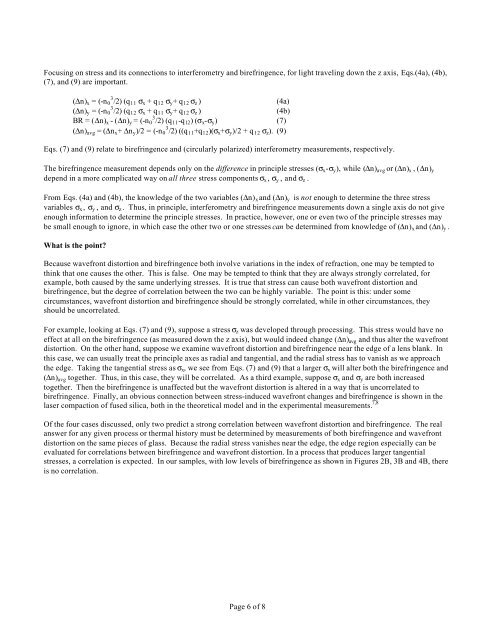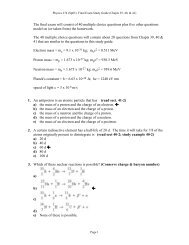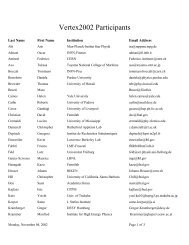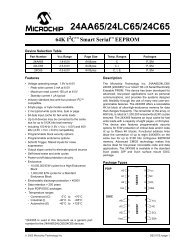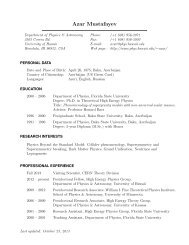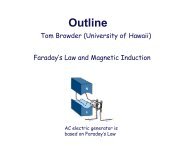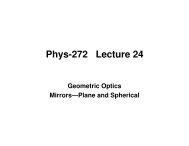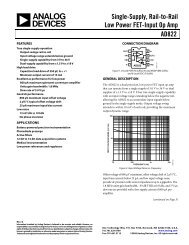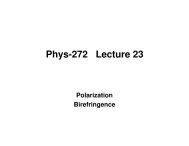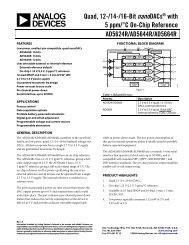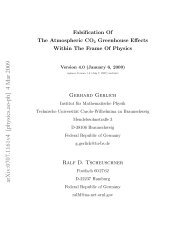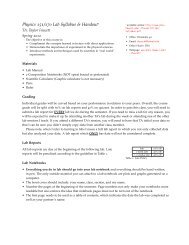Impact of Residual Stress in HPFS Fused Silica
Impact of Residual Stress in HPFS Fused Silica
Impact of Residual Stress in HPFS Fused Silica
Create successful ePaper yourself
Turn your PDF publications into a flip-book with our unique Google optimized e-Paper software.
Focus<strong>in</strong>g on stress and its connections to <strong>in</strong>terferometry and birefr<strong>in</strong>gence, for light travel<strong>in</strong>g down the z axis, Eqs.(4a), (4b),<br />
(7), and (9) are important.<br />
(∆n) x = (-n 3 0 /2) (q 11 σ x + q 12 σ y + q 12 σ z )<br />
(4a)<br />
(∆n) y = (-n 3 0 /2) (q 12 σ x + q 11 σ y + q 12 σ z )<br />
(4b)<br />
BR = (∆n) x - (∆n) y = (-n 3 0 /2) (q 11 -q 12 ) (σ x -σ y ) (7)<br />
(∆n) avg = (∆n x + ∆n y )/2 = (-n 3 0 /2) ((q 11 +q 12 )(σ x +σ y )/2 + q 12 σ z ). (9)<br />
Eqs. (7) and (9) relate to birefr<strong>in</strong>gence and (circularly polarized) <strong>in</strong>terferometry measurements, respectively.<br />
The birefr<strong>in</strong>gence measurement depends only on the difference <strong>in</strong> pr<strong>in</strong>ciple stresses (σ x -σ y ), while (∆n) avg or (∆n) x , (∆n) y<br />
depend <strong>in</strong> a more complicated way on all three stress components σ x , σ y , and σ z .<br />
From Eqs. (4a) and (4b), the knowledge <strong>of</strong> the two variables (∆n) x and (∆n) y is not enough to determ<strong>in</strong>e the three stress<br />
variables σ x , σ y , and σ z . Thus, <strong>in</strong> pr<strong>in</strong>ciple, <strong>in</strong>terferometry and birefr<strong>in</strong>gence measurements down a s<strong>in</strong>gle axis do not give<br />
enough <strong>in</strong>formation to determ<strong>in</strong>e the pr<strong>in</strong>ciple stresses. In practice, however, one or even two <strong>of</strong> the pr<strong>in</strong>ciple stresses may<br />
be small enough to ignore, <strong>in</strong> which case the other two or one stresses can be determ<strong>in</strong>ed from knowledge <strong>of</strong> (∆n) x and (∆n) y .<br />
What is the po<strong>in</strong>t?<br />
Because wavefront distortion and birefr<strong>in</strong>gence both <strong>in</strong>volve variations <strong>in</strong> the <strong>in</strong>dex <strong>of</strong> refraction, one may be tempted to<br />
th<strong>in</strong>k that one causes the other. This is false. One may be tempted to th<strong>in</strong>k that they are always strongly correlated, for<br />
example, both caused by the same underly<strong>in</strong>g stresses. It is true that stress can cause both wavefront distortion and<br />
birefr<strong>in</strong>gence, but the degree <strong>of</strong> correlation between the two can be highly variable. The po<strong>in</strong>t is this: under some<br />
circumstances, wavefront distortion and birefr<strong>in</strong>gence should be strongly correlated, while <strong>in</strong> other circumstances, they<br />
should be uncorrelated.<br />
For example, look<strong>in</strong>g at Eqs. (7) and (9), suppose a stress σ z was developed through process<strong>in</strong>g. This stress would have no<br />
effect at all on the birefr<strong>in</strong>gence (as measured down the z axis), but would <strong>in</strong>deed change (∆n) avg and thus alter the wavefront<br />
distortion. On the other hand, suppose we exam<strong>in</strong>e wavefront distortion and birefr<strong>in</strong>gence near the edge <strong>of</strong> a lens blank. In<br />
this case, we can usually treat the pr<strong>in</strong>ciple axes as radial and tangential, and the radial stress has to vanish as we approach<br />
the edge. Tak<strong>in</strong>g the tangential stress as σ x , we see from Eqs. (7) and (9) that a larger σ x will alter both the birefr<strong>in</strong>gence and<br />
(∆n) avg together. Thus, <strong>in</strong> this case, they will be correlated. As a third example, suppose σ x and σ y are both <strong>in</strong>creased<br />
together. Then the birefr<strong>in</strong>gence is unaffected but the wavefront distortion is altered <strong>in</strong> a way that is uncorrelated to<br />
birefr<strong>in</strong>gence. F<strong>in</strong>ally, an obvious connection between stress-<strong>in</strong>duced wavefront changes and birefr<strong>in</strong>gence is shown <strong>in</strong> the<br />
laser compaction <strong>of</strong> fused silica, both <strong>in</strong> the theoretical model and <strong>in</strong> the experimental measurements. 7,8<br />
Of the four cases discussed, only two predict a strong correlation between wavefront distortion and birefr<strong>in</strong>gence. The real<br />
answer for any given process or thermal history must be determ<strong>in</strong>ed by measurements <strong>of</strong> both birefr<strong>in</strong>gence and wavefront<br />
distortion on the same pieces <strong>of</strong> glass. Because the radial stress vanishes near the edge, the edge region especially can be<br />
evaluated for correlations between birefr<strong>in</strong>gence and wavefront distortion. In a process that produces larger tangential<br />
stresses, a correlation is expected. In our samples, with low levels <strong>of</strong> birefr<strong>in</strong>gence as shown <strong>in</strong> Figures 2B, 3B and 4B, there<br />
is no correlation.<br />
Page 6 <strong>of</strong> 8


